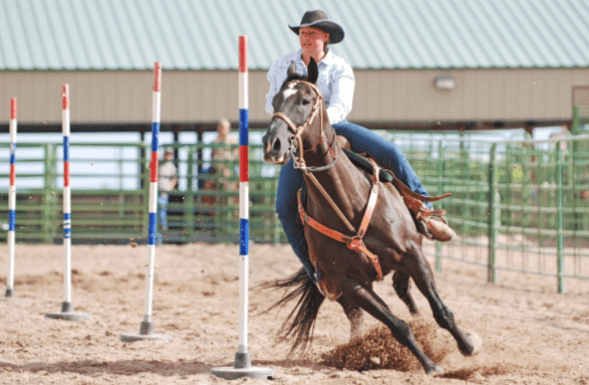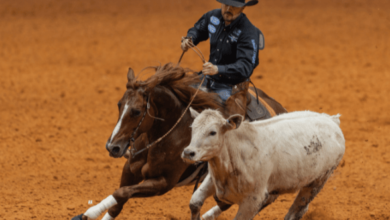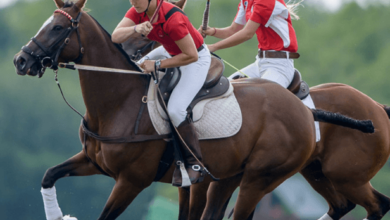Pole bending is an exciting and competitive sport that requires agility, speed, and precision from both horse and rider. This rodeo event involves weaving through a series of poles set in a line, challenging both your horse’s ability to maneuver and your control as a rider. Teaching your horse to pole bend can strengthen your bond and improve your horse’s responsiveness. This article will guide you through the process of training your horse for pole bending, covering everything from initial groundwork to mastering advanced techniques.
Understanding Pole Bending Basics
Pole bending consists of six poles set 21 feet apart, with the horse required to weave through them in a serpentine pattern. Speed is essential, but so is accuracy. If a horse knocks down a pole, time penalties apply, so precision is as important as speed. Training your horse to perform well in pole bending requires patience, consistency, and gradual progress.
Preparing Your Horse for Pole Bending
Before beginning pole bending training, ensure your horse is physically fit and in good health. Pole bending requires a lot of lateral movement and agility, which can put strain on your horse’s muscles and joints. Start with a basic fitness routine to build stamina, focusing on:
- Cardio Conditioning: Short bursts of cantering or trotting to improve cardiovascular endurance.
- Strength Training: Work on strengthening your horse’s core muscles with activities like hill work or ground poles.
- Flexibility Exercises: Regularly include stretching exercises to keep your horse limber and prevent injuries.
A well-conditioned horse will be more responsive and better able to navigate the poles without strain or injury.
Building Trust and Communication
A strong relationship between you and your horse is crucial for success in pole bending. Focus on groundwork exercises that build communication, trust, and responsiveness:
- Lunging: Lunging helps improve your horse’s ability to follow cues and understand your body language. It also allows you to practice speed control, which is vital for pole bending.
- Yielding Exercises: Teach your horse to yield to pressure by asking it to move its hindquarters or forequarters away from gentle pressure. This will help later when you need your horse to pivot sharply around a pole.
- Desensitization Training: Introduce your horse to the sight and presence of poles during groundwork. Let them sniff the poles, walk around them, and get comfortable before adding any complexity.
Introducing the Poles
Once your horse is comfortable with groundwork, it’s time to introduce the poles. Start by walking your horse around the setup to familiarize it with the layout. This step helps the horse understand that the poles are part of the environment and not something to be afraid of. Keep the sessions short to avoid overwhelming your horse.
Step-by-Step Pole Bending Training
Step 1: Walking Through the Pattern
Begin by walking your horse through the pole bending pattern. Focus on keeping a steady pace and making wide, gentle turns around each pole. At this stage, speed is not important. The goal is to ensure your horse understands the basic path it needs to follow.
- Consistency is Key: Practice walking through the pattern several times per session, focusing on smooth and controlled movements.
- Use Verbal Cues: Incorporate voice commands like “walk,” “easy,” or “whoa” to guide your horse through the pattern. This will help the horse understand what you want.
Step 2: Trotting Through the Pattern
Once your horse is comfortable walking through the poles, you can start trotting. Keep your focus on maintaining control rather than speed. Trotting helps your horse learn to maneuver around the poles without rushing. Practice this phase until your horse can weave through the pattern smoothly without knocking over any poles.
- Body Language: Use your body language and reins to cue your horse to turn at the right moment. A light touch on the reins combined with leg pressure will help guide your horse around the poles.
- Repetition: Repetition helps build muscle memory. The more you practice at a trot, the more confident and balanced your horse will become.
Step 3: Adding Speed
After mastering the pattern at a trot, gradually increase the speed. Start with a lope (a slow canter) as you enter the poles, slowing to a trot for the weave, and then loping out again. Over time, reduce the amount of trotting until your horse can complete the entire pattern at a lope or faster.
- Focus on Precision: It’s easy to get caught up in the excitement of speed, but it’s important to maintain accuracy. If your horse starts to cut corners or knock over poles, slow down and reinforce the basics.
- Controlled Turns: Practice turning tightly around each pole while maintaining balance. If your horse struggles with tight turns, return to groundwork exercises to improve its flexibility.
Tips for Successful Pole Bending Training
- Keep Sessions Short and Positive: Limit training sessions to 20-30 minutes to avoid mental and physical fatigue. End each session on a positive note, whether that means successfully weaving through the poles at a trot or maintaining calmness around the setup.
- Reward Good Behavior: Reinforce good behavior with treats, gentle pats, or a rest period after a successful run. This positive reinforcement helps your horse understand what behavior is expected.
- Gradual Progression: If your horse struggles with a particular stage, go back to the previous step and build up again. It’s important to avoid rushing the process, as frustration can lead to a lack of trust between you and your horse.
Common Challenges in Teaching Pole Bending
- Knocking Down Poles: This often occurs when a horse is moving too quickly or not turning tightly enough. Slow down and practice weaving through the poles at a walk or trot until your horse masters the tight turns.
- Refusing to Enter the Pattern: If your horse is hesitant, return to desensitization exercises around the poles. Allow your horse to stand near the poles and reward them for calm behavior.
- Inconsistent Speed: To address varying speeds, work on transitions between different gaits outside of the pole pattern. This will help your horse learn to adjust its pace based on your cues.
Advanced Techniques for Competitive Pole Bending
Once your horse is confidently maneuvering through the poles at speed, you can begin refining the technique for competitive pole bending.
- Counter-Arc Training: Teach your horse to arc its body in the opposite direction while turning around a pole, allowing for tighter, more efficient turns.
- Rate Training: Focus on getting your horse to slow down and rate (gather itself) before each turn, then speed up again between poles. This helps maintain control even at high speeds.
- Rollbacks: A rollback is a quick pivot on the hindquarters that can be useful when turning tightly around poles. This advanced maneuver requires a lot of hind-end strength and should be practiced gradually.
Safety Considerations for Pole Bending
- Use Proper Gear: A properly fitting saddle and bridle are essential to ensure the comfort of both horse and rider. Use protective boots on your horse’s legs to minimize the risk of injury during sharp turns.
- Warm Up Thoroughly: Always start with a warm-up routine before training to prevent injuries. A good warm-up includes light trotting and stretching exercises.
- Monitor for Signs of Fatigue: Pole bending can be physically demanding, so watch for signs that your horse is tired or stressed. If your horse begins to resist, slow down or end the session to avoid injury.
Conclusion
Teaching your horse pole bending can be a rewarding journey, enhancing both your horsemanship skills and the bond you share with your horse. Patience, consistency, and a focus on building a strong foundation are key to achieving success. With time and practice, your horse can become a confident and agile pole bender, ready to tackle competitions or simply enjoy a challenging new skill. Remember, the process is just as important as the result, so enjoy the journey with your equine partner.





